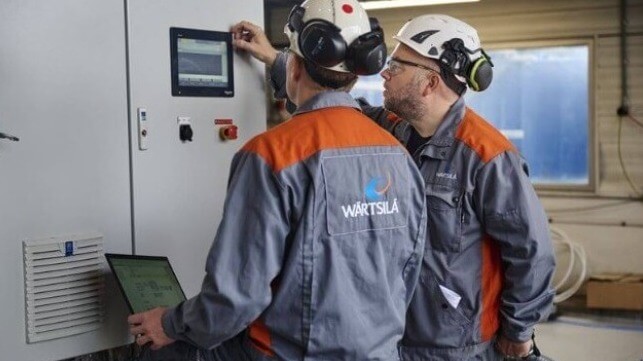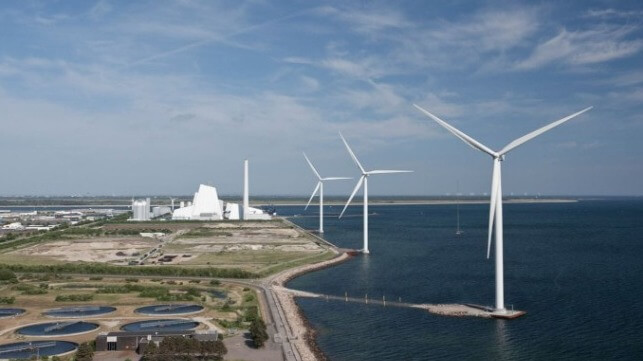Wärtsilä Offers Onboard Carbon Capture and Storage Feasibility Studies
With CCS-Ready scrubbers now being sold at pace, Wärtsilä’s studies across a range of vessel types come as next step in rapidly accelerating trajectory for CCS in shipping

[By: Wärtsilä]
Technology group Wärtsilä is now offering carbon capture and storage (CCS) feasibility studies to shipowners and operators, in another milestone on its journey to research, develop and bring to market maritime CCS technologies. The studies have already been conducted on a range of vessel types including ro-ro and ro-pax vessels, a drill ship, a container vessel and a gas carrier.
The process takes four to six months of study and design work. Wärtsilä Exhaust Treatment’s experts are involved in ship design at an early stage to conduct engineering work to understand how CCS can be smoothly integrated once the technology is launched to market.
Wärtsilä is conducting the feasibility studies across both newbuild and existing vessels. Retrofit CCS installations will be significantly smoothed by the presence of a scrubber onboard. Wärtsilä Exhaust Treatment is already offering CCS-Ready scrubbers to the market, which are integrated onboard in a way that enables a CCS system to be added easily in the future once the technology is commercialised.
Once completed, the CCS feasibility study work enables Wärtsilä to provide customers with a fully rounded commercial offer that can be shared with shipyards to get an exact quote for installation. During the feasibility studies, Wärtsilä’s experts closely examine the existing naval architecture of the ship and work to understand how the power, space and exhaust demands of CCS can be accommodated onboard. Owners will receive a qualified analysis of the costs of CCS integration, and a clear list of considerations on how a potential retrofit would be conducted in the least intrusive way.
Conducting the studies today enables Wärtsilä to bring forward the early stages of CCS integration and, in doing so, lower the barrier to entry once the technology is commercialised in the near future. The studies also serve to educate customers on the upsides and particular considerations associated with installing CCS onboard their vessels. Finally, as the studies will run in parallel with the implementation of new environmental regulations for shipping, owners who conduct them today will be ‘ahead of the curve’ versus their peers.
Sigurd Jenssen, Director, Wärtsilä Exhaust Treatment, said: “Launching these feasibility studies and being able to offer them to market is the exciting latest step in our process of bringing carbon capture and storage to market in shipping. It builds on the market-leading work we are conducting in our test hall in Moss, where our technology is already demonstrating our targeted 70% capture rate, and enables us to directly engage with customers to smooth the CCS adoption process in the near future.”
Jenssen continued: “By conducting these studies today, we are already building a considerable track record and understanding of how this technology will work across multiple vessel types. It builds on the considerable uptake we have already seen for our CCS-Ready scrubbers, which show that the industry is not only exploring CCS as a speculative technology, but is actively investing in its foundations as a decarbonisation solution. We look forward to conducting more of these studies in the coming months as we work to bring our CCS system to market.”
When a customer opts for a Wärtsilä CCS-Ready scrubber, the company takes measures during the scrubber installation process to ensure adequate space for the future installation of CCS system. CCS-Ready scrubbers are also designed to enable smooth integration with a Particulate Matter filter.
Wärtsilä Exhaust Treatment is the market-leading marine exhaust gas cleaning system manufacturer, with a range of lifecycle solutions. Wärtsilä offers integrated compliant solutions for all types of ships, and in open loop, closed loop or hybrid configurations. Wärtsilä’s scrubbers are built with a modular approach to future technology development, creating a platform for the abatement of other emissions from shipping beyond sulphur.
Denmark Allocates $3.9B to Carbon Capture/Storage as it Accelerates Timing

Denmark announced a comprehensive plan for carbon capture and storage that includes significant government support as the country also accelerates its timeline while saying that CO2 capture and storage is one of several critical tools to achieve climate goals in Denmark, Europe, and the rest of the world. The announcement of the new plan comes just a week after Denmark postponed its second tender for offshore CO2 storage saying the government needed to finalize a comprehensive plan that resolved government participation in the industry.
“We are moving the requirement for full capture from 2030 to 2029 so that we get more CO2 from the air and into the underground faster,” said says Climate, Energy and Supply Minister Lars Aagaard during a briefing about the new plan at Avedøreværket, a power station just south of Copenhagen. “The plan must also ensure a clearer framework for the burgeoning industry and in this way bring the Danish CCS industry up in scale and down in price. It may well be that it's geeky, but it's in the geekery that things happen.”
The plan was presented as a comprehensive approach to with the government stressing that by pooling resources and creating clear framework conditions for CO2 capture and storage it was providing clarity to Danish industry. The energy minister was joined by Business Minister Morten Bødskov and Transport Minister Thomas Danielsen in presenting the new plan.
Instead of smaller tenders, the government plans to launch two large, comprehensive tenders, one in 2024 and a second in 2025. They plan to invest approximately $3.9 billion, with approximately $1.5 billion for the 2024 tender and a further nearly $2.4 billion in 2025 allocated over a 15-year period to support the programs. The goal for 2024 is to set up plans for 0.9 million tons of carbon capture and storage and a further 1.4 million tons in the 2025 tender. Going forward the government will continue to hold 20 percent state ownership, which is the model that was used for the first three licenses and the key point that the ministry said needed to be resolved before the next offshore tender.
While saying as a country Denmark must capture at least 3.2 million tons of CO2 annually by 2030, the new plan moves forward by one year the requirement for the programs to 2029. They said the possibility is also provided to start the large-scale capture and storage efforts by 2028.
The plan also ensures clear framework conditions for the industry regarding ownership and regulation for the transport of CO2 via pipes. Among other things, the government said it will expand the existing rules for the transport of CO2 to include all forms of CO2 transport, which is particularly important for the transport of CO2 for use in PtX facilities and for CO2 that must be shipped via ports for offshore storage.
The goal in addition to providing greater clarity was to increase the size and scope so that more companies can bid and participate in the efforts.
Denmark earlier this year awarded the first exploration licenses for offshore carbon storage after providing a provisional license for the testing and demonstration of the world’s first offshore storage operation. In addition, they awarded the first licenses for industrial plants to establish capture initiatives first centered on one of Ørsted’s plants but designed to also create the infrastructure for other industrial emitters to participate.
No comments:
Post a Comment